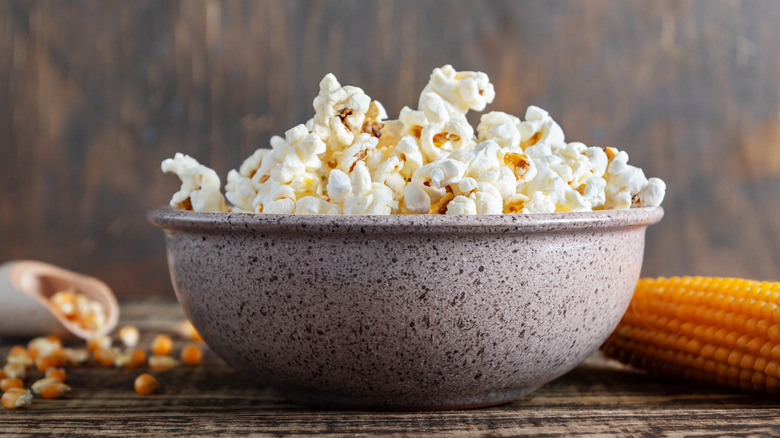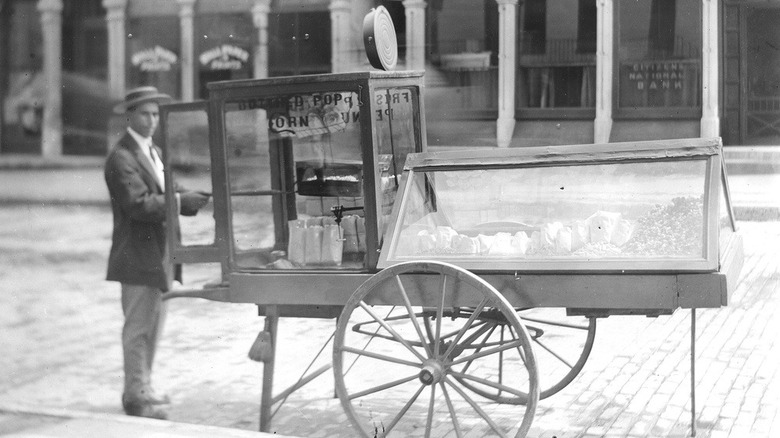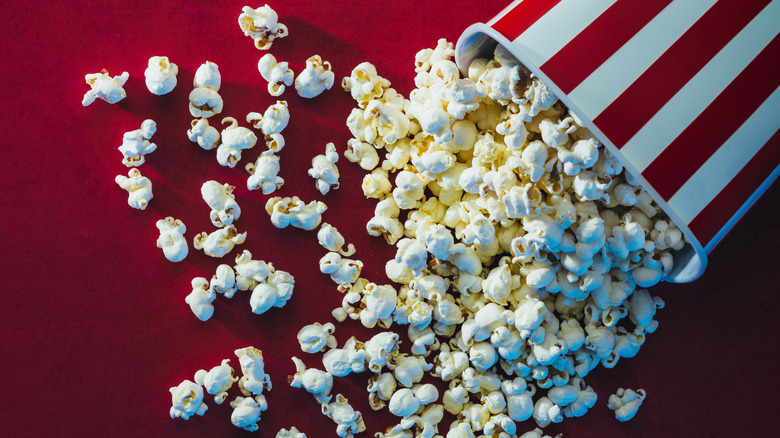Popcorn Is Emerging As 2023's Inflation-Proof Go-To Snack
Throughout the Great Depression, necessities were hard to come by. Food was overpriced and undersupplied, jobs were scarce, and giant dust storms devastated homes and farms. They were trying times, and while nearly 100 years have passed since, many of these effects still hit home today. That said, finding malleable, tasty, nutritionally beneficial, and budget-friendly food is essential for modern shoppers and snackers. But where does such food exist? It's likely already in your cabinets, hidden in a brown bag encased with thin plastic.
Popcorn has always been a financially reliable snack. Throughout the '30s, vendors would set up their mobile machines near movie theaters to provide freshly popped, buttered, and salted popcorn to movie-goers as they passed by. It was a food that seemed grandeur in taste and nature, yet it was priced at just a nickel. And despite its increase in consumer demand, primarily due to the introduction of "talkies" and the Golden Age of Hollywood, it stayed this way.
By the 1940s, our perception of this crunchy food changed. What was once solely associated with the entertainment industry quickly became an everyday snack due to the high cost of sugar. Americans relied on popcorn more than ever to satisfy cravings and achieve that feel-full sensation, and many of these qualities are still desired today. But what makes popcorn so resilient to inflation, especially compared to other snacks that have tripled in cost?
A timeless snack that has provided throughout the ages
The snack industry is a competitive business. With food trends constantly moving and inflation on the rise, it can be challenging to decide which snack will provide the most bang for your buck. Take potato chips, for example. As satisfying as they are, the cost of one 8-ounce bag has jumped from roughly $1.98 in 1980 to nearly $6 in 2023 with a higher air-to-chip ratio. Popcorn, on the other hand, has stayed relatively the same in price and volume throughout the past century. Today, a single pouch of popcorn from a 12-bag box costs only $0.53. It also provides a higher return due to its expansive capabilities.
Overall, popcorn is inflation-proof for everyone. For producers, it's an easily profitable crop that requires little production and reaps incredible results. For consumers, it's portable, easily sharable, and incredibly filling. It's also a fibrous heart-friendly food that can potentially aid your digestive and circulatory systems. But most importantly, there's always room in the budget for it, even on a tight one.
If it's cost-effective, why is popcorn so expensive at the movie theater?
Forget catching the new box office hit in the movie theater; we're here for the popcorn. Yes, devouring handfuls of yellow kernels drowned in butter and salt can seem like a grand event in itself, with or without the accompanying picture. But for nearly $7 a bag, it can also seem quite a gamble.
Movie theaters don't primarily rely on ticket sales to keep their doors open and their projectors rolling. It's the popcorn and concessions stand that keeps the industry alive. Although theaters typically receive more money from ticket sales, they often don't see a significant profit. Studios and movie distributors soak up most of this income. This means cinemas are left toying with the short end of the stick – usually between 30 and 40%.
Conversely, concessions are 80 to 90% profitable, making popcorn a lifeline for movie theaters and patrons alike. And while this can drive the price up, many theater companies have countered these steep prices with inexpensive movie tickets. Between monthly subscriptions (with additional discounts), matinee prices, and other special screenings, the main priority for these theaters is to get guests in seats and popcorn stuck between them.


